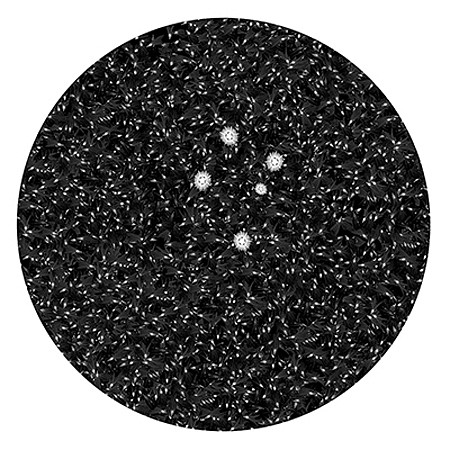
REVIEW: Dornith Doherty at the Dayton Art Institute
November 3, 2020 - Susan Byrnes of WYSO's Culture Couch
In my hand I’m holding a random assortment of seeds I collected from a recent walk in a prairie. If I hadn’t collected them myself, I might think they were tiny specks of dry, broken grass or leaves. I might not even see them at all, they appear so insignificant, like dust or lint from the inner reaches of a pocket.
In a new exhibit at the Dayton Art Institute called “Archiving Eden”, photographer Dornith Doherty turns her lens to the critical issue of seed saving, and global efforts to conserve the world’s food sources. Her compositions use Xrays of seeds and plants along with documentary images from facilities around the world working to sustain the planet’s biodiversity.
Archiving Eden provides insight into the under-appreciated magic contained in a seed. Doherty shows you inside the seeds, using digital collages made of the X-rays that she’s altered.
“One of the photographs I really enjoy is called “More Than This”, and it’s a lenticular panel of 5000 X-rays of seeds," says exhibit curator Kathryn Ryckman Siegwarth. "And a lenticular panel is essentially a hologram effect, so as you’re looking at this seemingly static object, there’s suddenly an aspect of depth and motion as you move around the object, and it brings life to these objects that are essentially in suspended animation. So it’s a very interesting and poetic way to discuss elongating the lives of seeds for the future.”
You also see photographs of seed banks the artist visited, like the Svalbard Global Seed Vault in Norway.
Opened in 2008 as the world’s largest secure seed storage, it’s Arctic location is designed to remain above water in the event of melting ice caps to safeguard some of the planet’s most important seeds.
“When I walked in it was just the most amazing space. It’s tunneled down super deep inside the top of a mountain on an island that is like 600 miles from the North Pole,” Dornith Doherty says.
Doherty’s early photography focused on national park landscapes, which she saw as giant gardens. Then she read a story in the New Yorker called “Sowing for Apocalypse” about the incredible effort it took to create the global seed vault as Svalbard. That’s when she shifted from giant garden to tiny seed.
Doherty says,“So the notion of trying to steward natural resources through to the future generations was really what attracted me to this project… and the fact that there’s like a kernel of hope. You know so much of the narrative right now about climate change is that individual actions don’t really make a difference, that we need to change on a global scale, and of course that’s true, but one of the things that’s interesting is there’s a very small group of scientists working on preserving seeds, and that has a huge impact. And I’ve encountered stories of species surviving against the odds again and again, at almost every seed bank there’d be some extraordinary story of seeds from 200 years ago, of a plant that’s now extinct in the wild was somehow, almost by accident preserved.”
Doherty’s art involves extensive collaboration with scientists, and her adaptation of some of their techniques, such as X-ray imaging of seeds, blends the visual languages of science and art, which is what attracted curator Kathryn Siegwarth. Siegwarth says, “This is science-driven, its inquiry driven, her X-rays , while poetic are still maintaining a scientific accuracy. It shows how art can allow an audience to grasp giant concepts that are sometimes beyond us or outside of our daily lives.”
My favorite work in the show is called “Finite”. In an almost five foot diameter circle, hundreds of spiky seeds surrounding five larger seed pods float against a deep black background. At a distance, it looks like five suns surrounded by comets or shooting stars. Looking closer, you get absorbed into a mesmerizing cosmos that’s at once microscopic and galactic in scale. You could be looking at a Petrie dish or a porthole view into the universe. What you see is the genetic material that holds past and future at once, the speck of difference between life and death on our planet, which is ultimately ours to save.
Archiving Eden is on display at the Dayton Art Institute now through January 10th. Artist Dornith Doherty and exhibition curator Kathryn Ryckman Siegwarth will have a virtual discussion about the exhibition on Thursday, November 12 from noon until 1p.m. EST. The event is free but requires pre-registration at www.daytonartinstitute.org
Download Article (PDF)Back to News
